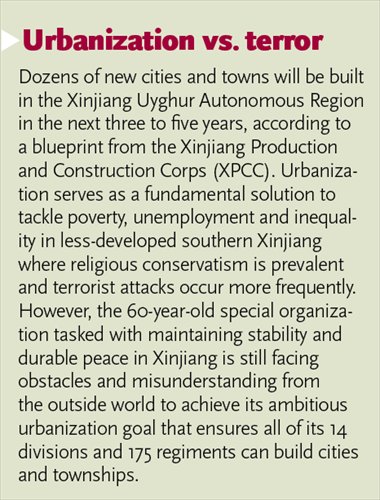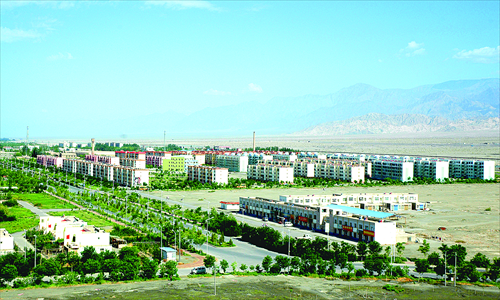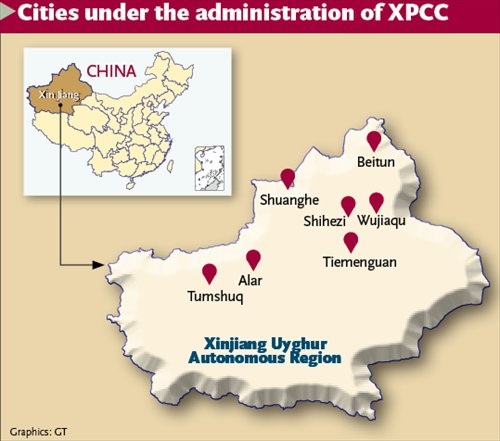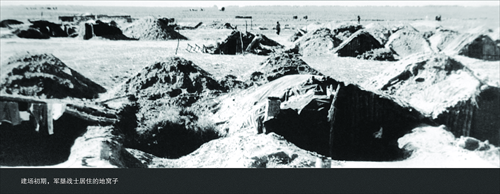Xinjiang to build cities from scratch in restive regions
Xinjiang to build cities from scratch in restive regions in economic boost

Urbanization vs. terror
After hours of driving along the highway from Korla to Luntai in the Bayingol Mongolian Autonomous Prefecture, located in southern Xinjiang, rows of modern apartments gleaming with white paint suddenly appear to break up the monotonous landscape in the Gobi Desert.
They are the residences of the 29th regiment of the Xinjiang Production and Construction Corps (XPCC), which has 14 divisions and 175 regiments across the Xinjiang Uyghur Autonomous Region. According to the central government's blueprint, each of the divisions is capable of building a city and each of the regiments can build a township.
After decades of efforts to reclaim the wasteland and develop the economy, the XPCC has turned its focus to southern Xinjiang, an area mainly inhabited by ethnic Uyghur people, that has been frequently attacked by terrorists.

The city of Tiemenguan, built by the XPCC in 2012. Photo: Courtesy of the XPCC
Going south
"The XPCC's development focus is building cities and gathering people together in the new era. The priority is building more cities and townships in southern Xinjiang as a means to maintain social stability and boost local development," Xu Weihua, the deputy political commissar of the XPCC, told the Global Times in an exclusive interview in Urumqi.
Southern Xinjiang's development lags behind northern Xinjiang by at least 10 years, according to estimates by some scholars. The "urbanization rate" (the proportion of people living in the urban area) of Kashi (also known as Kashgar), Hotan and the Kizilsu Kyrgyz Autonomous Prefecture stood at less than 30 percent by the end of 2012. Most locals are farmers and herdsmen working in the agriculture sector.
The XPCC has so far established seven cities, with three of them, Alar, Tumshuq and Tiemenguan, located in southern Xinjiang. Alar, Tumshuq were built in 2004, and Tiemenguan was built in 2012.
According to Xu, the 14th division of the XPCC plans to build a new city in Hotan, and pick up a batch of well-developed regiment farms or those with strategic significance, to build townships and further develop them into cities when conditions are mature.
More than 80 percent of the population in southern Xinjiang comes from ethnic minority groups. "Building cities and townships there is an urgent task and our priority, as the XPCC can use its economic and cultural advantages to help local people enjoy a modern and civilized social life," he said.
The XPCC has been pouring money into improving the livelihoods of ethnic minority groups. This year it plans to invest 543 million yuan ($87.42 million) to support the development of 19 regiment farms, with more than 30 percent of the workers at these farms coming from ethnic minority groups.
The efforts included helping local women in Hotan's Pishan farm develop a hand knitting business, and financing local youth to start their own businesses. Pishan is the hometown of the five suspects in the bombing of an Urumqi street market in May 22, which left 39 people dead and 94 injured.
"The establishment of cities and townships will also enhance the 'lifeblood function' of the XPCC, and reduce the central government's burden of fiscal transfer payments to the corps," Xu said.
The XPCC is China's only special social organization that has its own administrative and judicial bodies as well as armed police and militia groups. But it has no authority to collect taxes, so industrial and service enterprises affiliated with the XPCC need to pay taxes to local governments. In 2007, the Xinjiang regional government decided to refund some of the tax revenues generated by the XPCC's industrial firms to the XPCC, but some local officials said the policy has not been well implemented.
"A lack of tax revenues has limited the XPCC's development momentum. By setting up cities or townships, they could have the authority to collect taxes and achieve faster development," Pan Xingang, the head of the Institute of Economic Research with the XPCC, told the Global Times.
Aside from Shuanghe, which was established in April 2014, the other six XPCC cities generated 41 percent of the XPCC's total GDP in 2013.
Local residents in some newly established cities have also enjoyed double-digit income growth. For instance, the per capita income of urban residents and farmers in southern Xinjiang's Tiemenguan were 23,676 yuan and 16,206 yuan in 2013, higher than Xinjiang's average level of 19,874 yuan and 7,296 yuan during the same period.

Cities under the administration of XPCC
New role
The XPCC's role has always been highlighted when Xinjiang's social stability is under threat. It was established in 1954, repeating China's historical experience of stationing troops to reclaim the wasteland and guard frontiers in Xinjiang, a practice that can be traced back to the Western Han Dynasty (206BC-AD25).
During its early days, the XPCC built water conservancy works and reclaimed wasteland along the borders and edges of the Tianshan Mountain and the Taklimakan Desert. It also gradually formed a modern industrial system.
"The XPCC has laid a solid foundation for Xinjiang's economic development in its early stages," Pan said.
In Shihezi's Museum of Army Reclamation, many visitors are attracted by a worn-out winter coat with 296 colorful patches. This principal collection of the museum, together with trowels, human-hauled ploughs and stone mills, tells a story of how the oldest generation of the XPCC made efforts to build the city from almost nothing on the Gobi desert.
The XPCC was dissolved in 1975 amid the Cultural Revolution (1966-76), and top policymakers decided to revive it in 1981 after separatist activists tried to undermine social stability in Xinjiang. The XPCC, as Deng Xiaoping put it, is "the core of stabilizing Xinjiang."
During President Xi Jinping's inspection tour in Xinjiang late April, he also visited the XPCC and called to strengthen its role due to the new conditions. "More efforts are needed to build the XPCC into a stabilizer of the country's border areas, a melting pot that integrates various ethnic groups and a model region that showcases advanced productivity and culture," Xi said.
Nowadays the XPCC's contribution to Xinjiang's economic development is not as much as it was 60 years ago. It accounted for 17.4 percent of Xinjiang's GDP in 2013, compared to contributing one-third of the region's agricultural and industrial output in the 1960s.
"Pursuing economic growth should not be the XPCC's major task," Wang Dahao, an Urumqi-based writer and observer of Xinjiang issues, told the Global Times. "After years of creating material wealth for the local people, the XPCC should play an increasing role in delivering spiritual wealth."
As southern Xinjiang is mostly Uyghur, building cities there could aid the XPCC in promoting modern culture, said Wang. "But to achieve this goal, the XPCC also needs to bring in more minority people and increase the proportion of ethnic minority people in its total population," he added.
Developing southern Xinjiang has also been put on top of the agenda of the central government in the wake of a series of bloody terror attacks.
Measures such as creating jobs and improving education are seen as fundamental solutions to addressing the threat of terrorism. The central government has decided to roll out free high school education in southern Xinjiang. Shenzhen has also donated 1 billion yuan for the establishment of Kashgar University, the first comprehensive university in southern Xinjiang. New textile factories and steel mills are under construction in Kashi's special economic zone.
"Education is not confined to schools or universities, it's also in factories," said Pan. "By creating more jobs and attracting Uyghur youth to work in factories, the organizational culture could affect the way they interact with other groups and gradually change their behavior."

Holes dug in the earth used to accommodate the builders in the early years of the XPCC. Photo: Courtesy of the XPCC
Obstacles and misunderstandings
The XPCC built its first city Shihezi in 1976, and three more cities were built in 2004. Its fifth city, Beitun, was finally launched in 2011 even though the central government approved its establishment in 1997.
"To build a city or township, the XPCC needs to negotiate with the local government on the redistribution of resources, so it takes time," Pan said.
Realizing the XPCC's urbanization blueprint will not be an easy task. Given the XPCC's role of consolidating border defense and "not competing for benefits with the local people," most of its regiment farms are located along border areas or on the verge of the deserts, adding to the difficulty of its urbanization process, according to Wang.
The first central work conference of Xinjiang, held in 2010, served as a boost to the XPCC's urbanization drive. "Thanks to the increasing support from the central and regional governments, the pace at which the XPCC is building new cities has been speeding up since that meeting," Xu said.
A direct reflection was in the XPCC's urbanization rate, which rose by 12 percentage points to 62 percent in 2013 from 2010, higher than the national level of 53.7 percent and the Xinjiang level of 44.5 percent.
According to the XPCC's urbanization development plan for 2012-20, the XPCC aims to build one to two cities in 2014, and achieve the goal of ensuring all of its 14 divisions have built a city within the next three to five years.
"But urbanization is not just about building houses," Xu said. "We need to improve urban infrastructure and facilities, and develop the services industry to attract people and retain them."
In the 1950s and 1960s, many young college students came to the XPCC echoing the nation's call, and the salaries in the XPCC were also higher than they were in other provinces at that time. But with rapid development of other provinces and more violence erupting in Xinjiang, the XPCC has been faced with a talent drain in recent years, Tang Lijiu, head of Xinjiang Westeast Economic Research Institute, told the Global Times.
"The XPCC will make efforts to attract local talents, college graduates from other provinces, and retain the third generation of the XPCC," Xu noted.
There are also some misunderstandings about the XPCC when it aims to attract private investment, as many people associate the XPCC with the military, due to its literal meaning in Chinese.
When the XPCC launched an event in Hong Kong to attract local investment in May 2013, which was also the first such event outside the Chinese mainland since its establishment, there were some suspicions from local media about its purpose.
"But when we explained to them what we are, the misunderstanding was eliminated," Xu said. As a result, 33 projects totaling HK$108.2 billion were signed during the event.
"The economic development of the XPCC is not making ourselves live well, but is helping more local people live a better life and maintain social stability," he added.
Newspaper headline: New towns out of nowhere